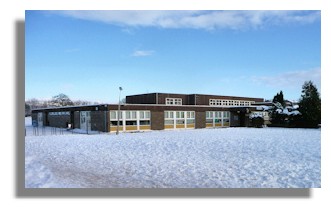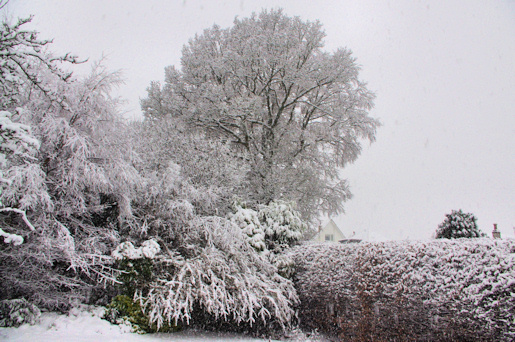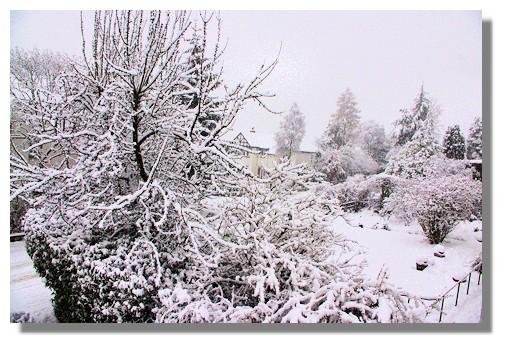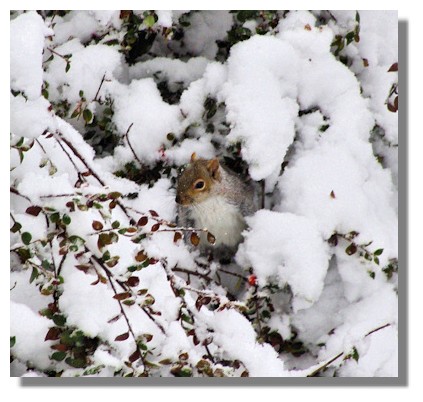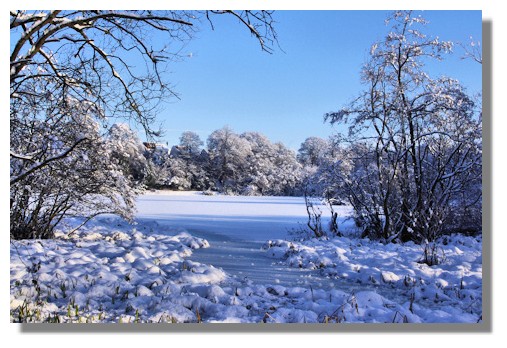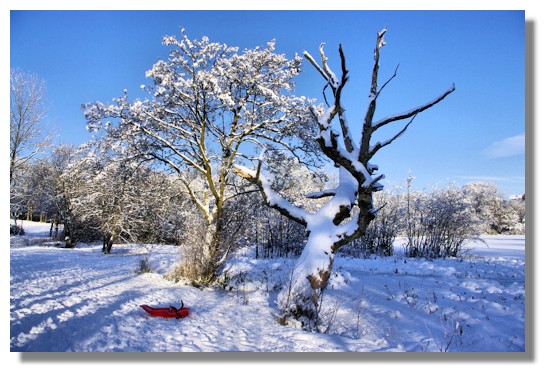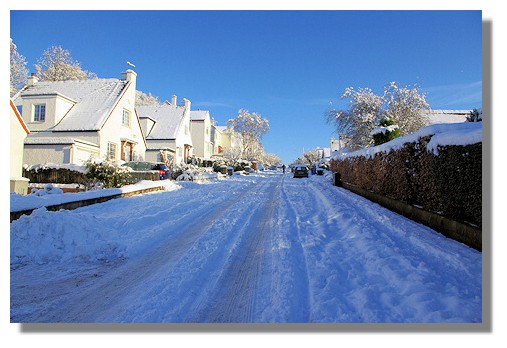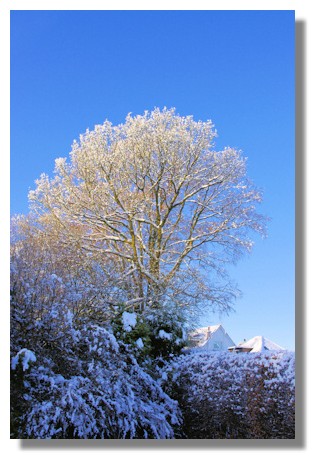Scottie's Diary
- Snowbound Scotland
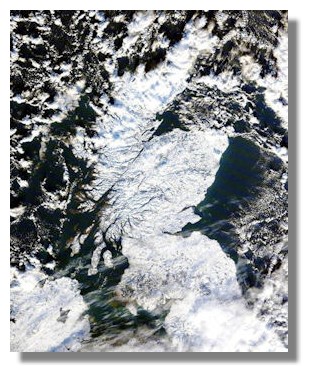
Snowbound Scotland From Space
Background
Scotland is on the same latitude as Labrador and Baffin Bay but, thanks to the Gulf Stream, warm water starts out in the Gulf of Mexico and drifts across the Atlantic to northern Europe, including the west coast of Scotland. So we usually experience much milder winters than the latitude would suggest. So much so that they cheekily grow palm trees on the coastal fringes of Scotland in places like Culzean Country Park in Ayrshire and Inverewe Garden at Poolewe even further north. In recent years, thanks no doubt to the impact of global warming, we've had a run of seven years of mild winters. The amount of snow falling even in the Highlands of Scotland has been declining and the commercial ski slopes have been suffering from lack of snow. They have even tried to diversify to create attractions in the summer to make up for lack of winter skiing. However, the lack of cold weather and snow changed in the most recent couple of years, with last winter producing months of freezing temperatures and lots of snow. The ski slopes had their largest number of skiers for many years. But we were told that was a "once in a lifetime" event... Even so, local authorities stocked up in advance and began the winter with 260,000 tonnes of road salt (they nearly ran out last winter) and took delivery of more gritter lorries to treat the roads.
November's Early Snow
But November this year broke records for the amount of snow and low temperatures, especially in the central Lowlands of Scotland. The unusual conditions - and some photographs of the snowy scenes - prompted me to write a diary page about the snowy scenes and traffic chaos - see A Snowy November if you didn't see that two weeks ago.
Travel Chaos
On the Monday after sending out that diary page, there was yet another heavy fall of snow in many parts of Scotland, including the central Lowlands which includes Edinburgh and Glasgow. It fell during the morning rush hour and created chaos on Scotland's roads with central Scotland's road network brought to a standstill. The lucky folk on some motorways and A-class roads only took ten hours to complete a journey that normally took them 30 minutes. The unlucky ones were trapped in their cars overnight, unable to move because of articulated lorries that had jack-knifed.
Thousands of vehicles were abandoned and hundreds of people were stuck in their cars overnight. Apart from a few locals from houses near the roads who went out with flasks of soup and tea, these motorists were just abandoned by the roads authorities and police. The police estimated that around 1,000 cars had been abandoned in the Strathclyde region alone. On the M876 alone, 650 cars and 350 lorries became stuck on the five-mile stretch of road near Falkirk. And some who abandoned their cars on motorways had to pay a hefty fine to get them back later from car pounds after they had been removed to allow gritters to operate more freely. On Tuesday morning, Strathclyde Police reported that the snow and ice on some roads was breaking the blades on snow ploughs. The M8, Scotland's busiest road, was closed for two days between Edinburgh and Glasgow. The weather caused a southbound closure on the Forth Road bridge when gridlock on the wider roads network caused traffic to back up on to the bridge from the A90 and M9 spur.
Even by Wednesday, schools in Glasgow, East Dunbartonshire, West Dunbartonshire, Renfrewshire and East Renfrewshire and Clackmannanshire, West Lothian, North Lanarkshire, South Lanarkshire and Falkirk were all closed. About 900 schools were shut, affecting more than 200,000 children who were away from classes yet again. Snow in the east of the country, in Edinburgh for example, was a foot deep and it was even deeper in East Kilbride, south of Glasgow.
The economic side effects of transport being so badly affected are widespread. There are the direct costs of dealing with the snow on the roads and the extra potholes created on roads that already had surfaces that would be regarded as sub-standard in a third-world country. And this should be the busiest time of the year for many retailers. But with police again warning motorists to only drive if the journey was absolutely essential, city and town centre shops were deserted and out of town shopping malls were eerily quiet. The surprise is perhaps that the Glasgow Chamber of Commerce estimate was that retail sales were down by only 25/35% so far this month.
Shops in smaller towns and villages benefitted to an extent as locals used them instead of travelling to larger supermarkets - so long as they in turn could somehow get supplies to stock the shelves. Even supermarket chains were having delivery problems with a number running short of bread and milk. Faced by ungritted, icy side roads for delivery vans, many supermarkets operating on-line ordering suspended the service for non food items in Scotland.
On Wednesday, the sections of the M8 motorway which had been closed for nearly 48 hours reopened, with a convoy of cars heading slowly along the road led by two snowploughs. The army was also drafted in to help clear the snow from areas surrounding hospitals and doctors' surgeries in Edinburgh and help transport residents in the Capital get to medical appointments.
By Friday, there was at last a break from the freezing temperatures with a slight thaw (which created its own problems with slushy roads which then froze again overnight). But at least last weekend saw retail outlets thronged as customers tried to catch up with their Christmas shopping.
Of course, the thaw didn't last and temperatures plummeted, especially overnight, during the following week.
Transport Minister Resigns
While nobody could blame the Scottish Transport Minister, Stewart Stevenson, for the snow, his immediate reaction was to blame the forecasters used by the government to predict the weather - even though many other forecasts, including those on BBC and commercial TV programmes, were full of warnings about the severity of the weather. The Meteorological Office gave an icy response to that excuse and accused the Minister of sliding away from the truth.. They claimed that their severe weather warnings had been issued nine hours ahead of the snowfall.
Eventually the minister apologised for "failing to communicate the position better and earlier" to travellers on Monday. The Scottish First Minister claimed that the authorities had been caught out by a "perfect storm" - while rattling off the actual depth of snow in various parts of central Scotland compared to the predictions given by the forecasters. As the week wore on, however, the Minister of Transport faced more calls to resign from opposition Members of the Scottish Parliament (who said they knew of the impending snowfall from TV news reports). The tabloid press also reflected the frustration of many members of the public.
Eventually, by the end of the week, the Transport Minister announced his resignation, saying that he "could have done much more to ensure that members of the public were better informed of the situation".
More Snow
We are now nearing the end of the third week of snow on the ground (or longer for Aberdeen and the north-east of the country) and forecasters warned of yet more freezing temperatures and snow driven by winds from the Arctic. Forecasters made doubly sure that everyone - even Scottish government transport ministers - were well warned in advance. On Thursday it was Aberdeen's turn to face yet more driving snow and traffic slowed to a crawl and the airport closed, including helicopter flights to North Sea oil rigs. While there were indeed more blizzard conditions in Aberdeen and the north east, much of the snow fell on Northern Ireland and north-east England with only a light covering - and icy roads in central Scotland. On Saturday there were more snow flurries in the heavily populated Central Lowlands but the main focus for snow was down in the south of England where heavy snow resulted in London Heathrow airport closing and flights at other airports around the UK capital were badly disrupted. Just to cheer us up, the weather forecasters say that if this cold weather continues (which is looking likely) this December is "almost certain" to be the coldest since records began - in 1910.
A White Christmas?
The forecast for next week and for Christmas sees no sign of daytime maximum temperatures getting above freezing point and dropping even lower every night. Whether we get any snow falling on Christmas Day remains to be seen - but the bookmakers are shortening the odds again..
Pictures in the Snow
Once again, the snow provide photo opportunities though with police advising that we should only travel by car if absolutely necessary, the photos were in my local suburban Glasgow area. In other years when there has been snow, there have often been cloud and overcast days after the snow. At least this year there have been a number of bright sunny days with blue skies that make for some delightful pictures!
The snow is falling heavily in this picture and kept on like that for a number of hours. It was that wet kind of snow that clings to branches and leaves - and is ideal for making a snowman!
At this stage I was taking photos from inside the house - I worked quickly as even opening the windows to avoid reflections created an icy blast inside!
The local squirrels must be getting puzzled by the way the snow arrives, departs and comes back again. Rather like the Transport Minister, they don't have any TV weather forecasters to give them prior warning...
Of course, it looks very pretty once the snow stops and the sun comes out. Although there is no water to be seen (it froze solid weeks ago) this is a small loch.
There is a small hill nearby and local children and some parents were taking advantage of the snow to go sledging. Needless to say, local shops ran out of the plastic sledges very quickly.
I always feel sorry for the folk who live on this hill. It is a dead end and so doesn't get a lot of traffic to churn up the snow.
This is the same tree that appeared further up the page showing the snow falling heavily.
If you want to read the other Diary entries going back to 2009, there is an Index page.
